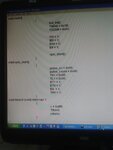pic.programmer
Advanced Member level 3
You can do like this.
After returning from myFunction(), myInt will hold 128 as the value that is before second loop.
Code:
unsigned int myInt = 32;
unsigned int myFunction1(unsigned int myLoclInt) {
return myLocalInt * 2;
}
unsigned int myFunction2(unsigned int myLoclInt) {
return myLocalInt * 2;
}
void main() {
while(1) {
myInt = myFunction1(myFunction2(myInt));
}
}After returning from myFunction(), myInt will hold 128 as the value that is before second loop.
